Kristen Grauman
PerceptionLM: Open-Access Data and Models for Detailed Visual Understanding
Apr 17, 2025



Abstract:Vision-language models are integral to computer vision research, yet many high-performing models remain closed-source, obscuring their data, design and training recipe. The research community has responded by using distillation from black-box models to label training data, achieving strong benchmark results, at the cost of measurable scientific progress. However, without knowing the details of the teacher model and its data sources, scientific progress remains difficult to measure. In this paper, we study building a Perception Language Model (PLM) in a fully open and reproducible framework for transparent research in image and video understanding. We analyze standard training pipelines without distillation from proprietary models and explore large-scale synthetic data to identify critical data gaps, particularly in detailed video understanding. To bridge these gaps, we release 2.8M human-labeled instances of fine-grained video question-answer pairs and spatio-temporally grounded video captions. Additionally, we introduce PLM-VideoBench, a suite for evaluating challenging video understanding tasks focusing on the ability to reason about "what", "where", "when", and "how" of a video. We make our work fully reproducible by providing data, training recipes, code & models.
Learning Activity View-invariance Under Extreme Viewpoint Changes via Curriculum Knowledge Distillation
Apr 07, 2025Abstract:Traditional methods for view-invariant learning from video rely on controlled multi-view settings with minimal scene clutter. However, they struggle with in-the-wild videos that exhibit extreme viewpoint differences and share little visual content. We introduce a method for learning rich video representations in the presence of such severe view-occlusions. We first define a geometry-based metric that ranks views at a fine-grained temporal scale by their likely occlusion level. Then, using those rankings, we formulate a knowledge distillation objective that preserves action-centric semantics with a novel curriculum learning procedure that pairs incrementally more challenging views over time, thereby allowing smooth adaptation to extreme viewpoint differences. We evaluate our approach on two tasks, outperforming SOTA models on both temporal keystep grounding and fine-grained keystep recognition benchmarks - particularly on views that exhibit severe occlusion.
Stitch-a-Recipe: Video Demonstration from Multistep Descriptions
Mar 18, 2025



Abstract:When obtaining visual illustrations from text descriptions, today's methods take a description with-a single text context caption, or an action description-and retrieve or generate the matching visual context. However, prior work does not permit visual illustration of multistep descriptions, e.g. a cooking recipe composed of multiple steps. Furthermore, simply handling each step description in isolation would result in an incoherent demonstration. We propose Stitch-a-Recipe, a novel retrieval-based method to assemble a video demonstration from a multistep description. The resulting video contains clips, possibly from different sources, that accurately reflect all the step descriptions, while being visually coherent. We formulate a training pipeline that creates large-scale weakly supervised data containing diverse and novel recipes and injects hard negatives that promote both correctness and coherence. Validated on in-the-wild instructional videos, Stitch-a-Recipe achieves state-of-the-art performance, with quantitative gains up to 24% as well as dramatic wins in a human preference study.
SPOC: Spatially-Progressing Object State Change Segmentation in Video
Mar 15, 2025Abstract:Object state changes in video reveal critical information about human and agent activity. However, existing methods are limited to temporal localization of when the object is in its initial state (e.g., the unchopped avocado) versus when it has completed a state change (e.g., the chopped avocado), which limits applicability for any task requiring detailed information about the progress of the actions and its spatial localization. We propose to deepen the problem by introducing the spatially-progressing object state change segmentation task. The goal is to segment at the pixel-level those regions of an object that are actionable and those that are transformed. We introduce the first model to address this task, designing a VLM-based pseudo-labeling approach, state-change dynamics constraints, and a novel WhereToChange benchmark built on in-the-wild Internet videos. Experiments on two datasets validate both the challenge of the new task as well as the promise of our model for localizing exactly where and how fast objects are changing in video. We further demonstrate useful implications for tracking activity progress to benefit robotic agents. Project page: https://vision.cs.utexas.edu/projects/spoc-spatially-progressing-osc
Switch-a-View: Few-Shot View Selection Learned from Edited Videos
Dec 24, 2024Abstract:We introduce Switch-a-View, a model that learns to automatically select the viewpoint to display at each timepoint when creating a how-to video. The key insight of our approach is how to train such a model from unlabeled--but human-edited--video samples. We pose a pretext task that pseudo-labels segments in the training videos for their primary viewpoint (egocentric or exocentric), and then discovers the patterns between those view-switch moments on the one hand and the visual and spoken content in the how-to video on the other hand. Armed with this predictor, our model then takes an unseen multi-view video as input and orchestrates which viewpoint should be displayed when. We further introduce a few-shot training setting that permits steering the model towards a new data domain. We demonstrate our idea on a variety of real-world video from HowTo100M and Ego-Exo4D and rigorously validate its advantages.
Progress-Aware Video Frame Captioning
Dec 03, 2024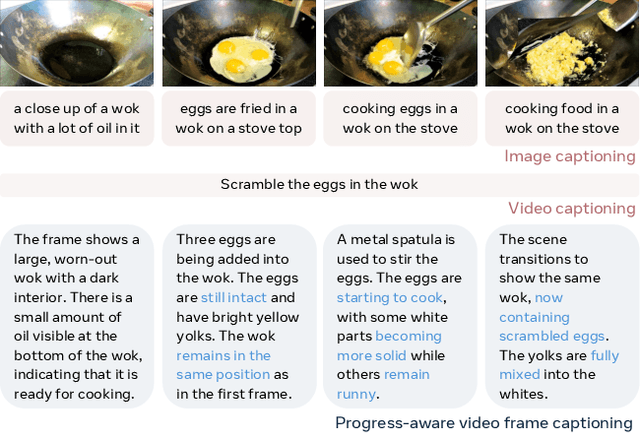
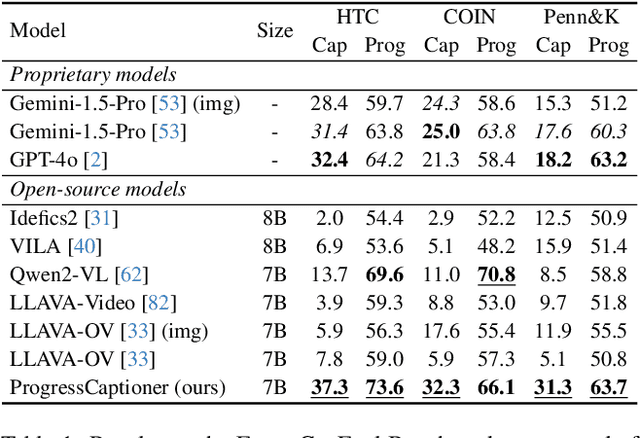
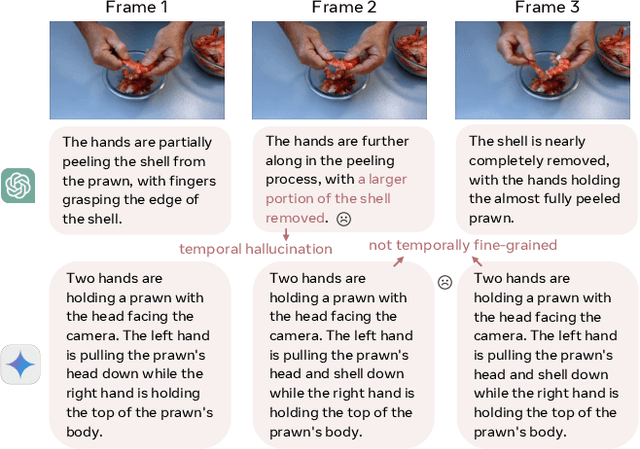

Abstract:While image captioning provides isolated descriptions for individual images, and video captioning offers one single narrative for an entire video clip, our work explores an important middle ground: progress-aware video captioning at the frame level. This novel task aims to generate temporally fine-grained captions that not only accurately describe each frame but also capture the subtle progression of actions throughout a video sequence. Despite the strong capabilities of existing leading vision language models, they often struggle to discern the nuances of frame-wise differences. To address this, we propose ProgressCaptioner, a captioning model designed to capture the fine-grained temporal dynamics within an action sequence. Alongside, we develop the FrameCap dataset to support training and the FrameCapEval benchmark to assess caption quality. The results demonstrate that ProgressCaptioner significantly surpasses leading captioning models, producing precise captions that accurately capture action progression and set a new standard for temporal precision in video captioning. Finally, we showcase practical applications of our approach, specifically in aiding keyframe selection and advancing video understanding, highlighting its broad utility.
FIction: 4D Future Interaction Prediction from Video
Dec 01, 2024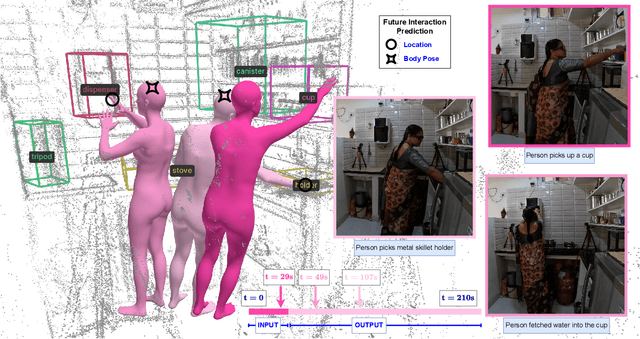

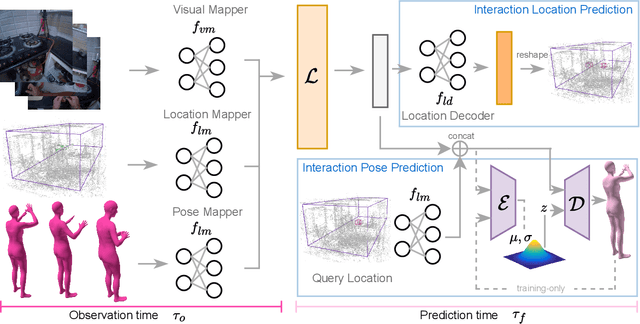
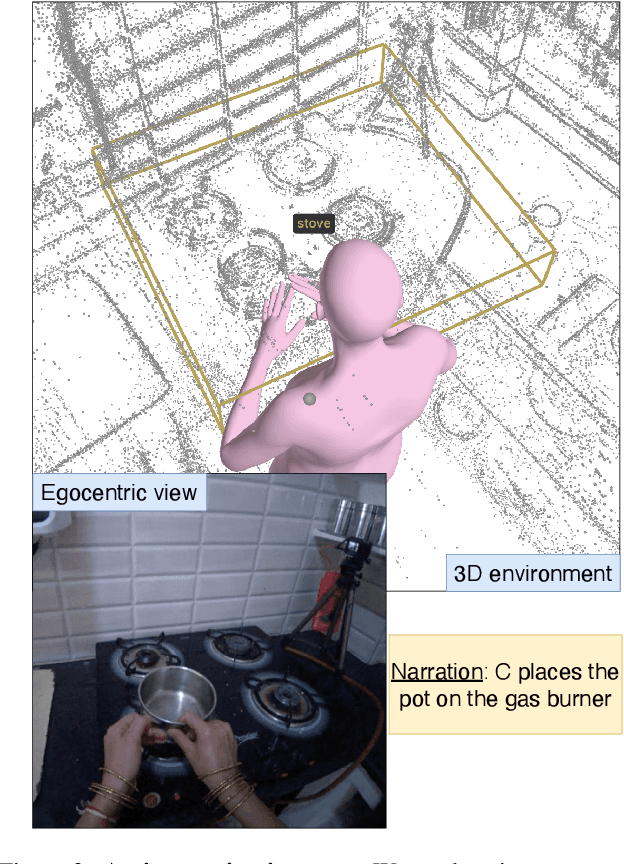
Abstract:Anticipating how a person will interact with objects in an environment is essential for activity understanding, but existing methods are limited to the 2D space of video frames-capturing physically ungrounded predictions of 'what' and ignoring the 'where' and 'how'. We introduce 4D future interaction prediction from videos. Given an input video of a human activity, the goal is to predict what objects at what 3D locations the person will interact with in the next time period (e.g., cabinet, fridge), and how they will execute that interaction (e.g., poses for bending, reaching, pulling). We propose a novel model FIction that fuses the past video observation of the person's actions and their environment to predict both the 'where' and 'how' of future interactions. Through comprehensive experiments on a variety of activities and real-world environments in Ego-Exo4D, we show that our proposed approach outperforms prior autoregressive and (lifted) 2D video models substantially, with more than 30% relative gains.
Which Viewpoint Shows it Best? Language for Weakly Supervising View Selection in Multi-view Videos
Nov 13, 2024



Abstract:Given a multi-view video, which viewpoint is most informative for a human observer? Existing methods rely on heuristics or expensive ``best-view" supervision to answer this question, limiting their applicability. We propose a weakly supervised approach that leverages language accompanying an instructional multi-view video as a means to recover its most informative viewpoint(s). Our key hypothesis is that the more accurately an individual view can predict a view-agnostic text summary, the more informative it is. To put this into action, we propose a framework that uses the relative accuracy of view-dependent caption predictions as a proxy for best view pseudo-labels. Then, those pseudo-labels are used to train a view selector, together with an auxiliary camera pose predictor that enhances view-sensitivity. During inference, our model takes as input only a multi-view video -- no language or camera poses -- and returns the best viewpoint to watch at each timestep. On two challenging datasets comprised of diverse multi-camera setups and how-to activities, our model consistently outperforms state-of-the-art baselines, both with quantitative metrics and human evaluation.
Human Action Anticipation: A Survey
Oct 17, 2024
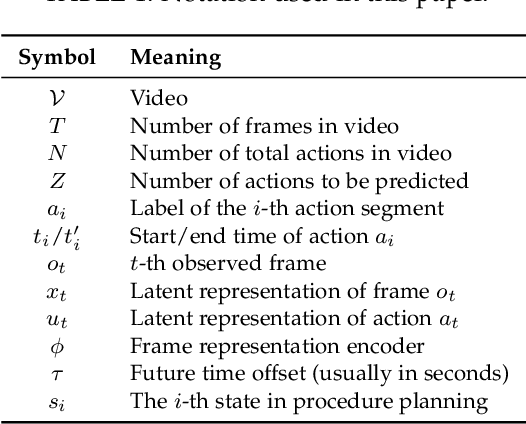
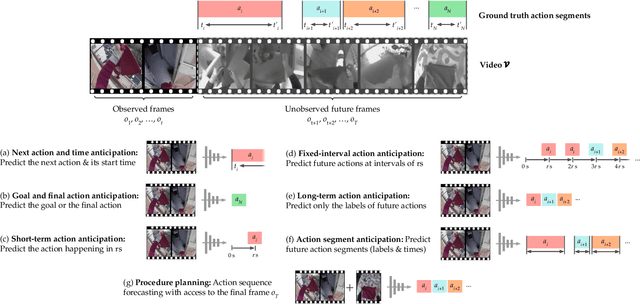
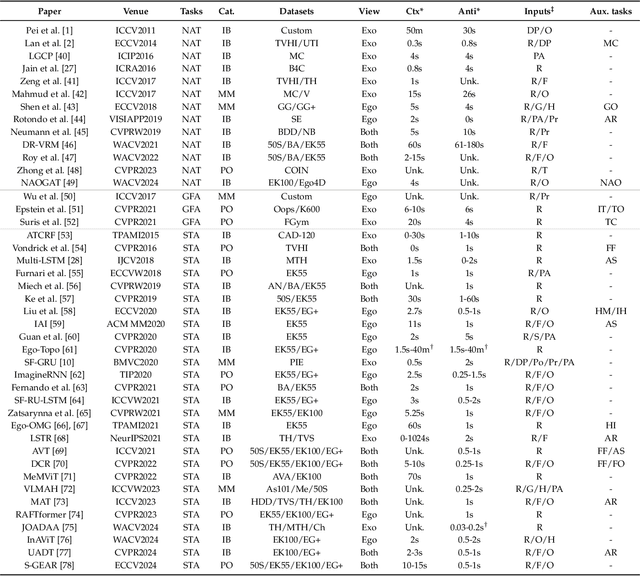
Abstract:Predicting future human behavior is an increasingly popular topic in computer vision, driven by the interest in applications such as autonomous vehicles, digital assistants and human-robot interactions. The literature on behavior prediction spans various tasks, including action anticipation, activity forecasting, intent prediction, goal prediction, and so on. Our survey aims to tie together this fragmented literature, covering recent technical innovations as well as the development of new large-scale datasets for model training and evaluation. We also summarize the widely-used metrics for different tasks and provide a comprehensive performance comparison of existing approaches on eleven action anticipation datasets. This survey serves as not only a reference for contemporary methodologies in action anticipation, but also a guideline for future research direction of this evolving landscape.
ExpertAF: Expert Actionable Feedback from Video
Aug 01, 2024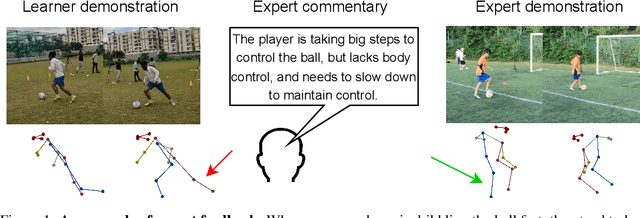
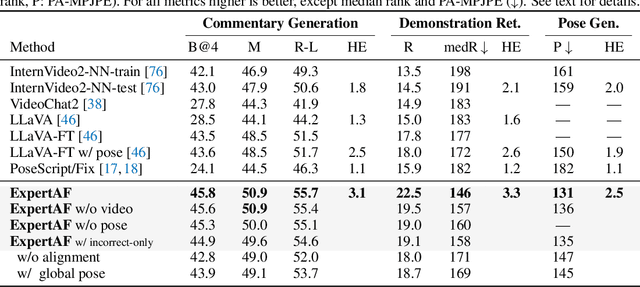
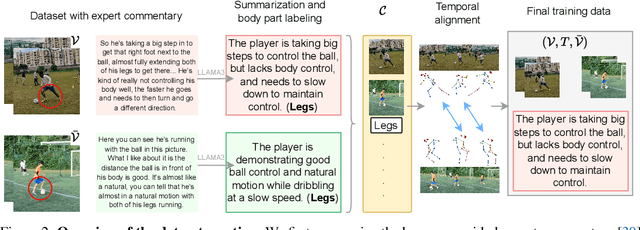
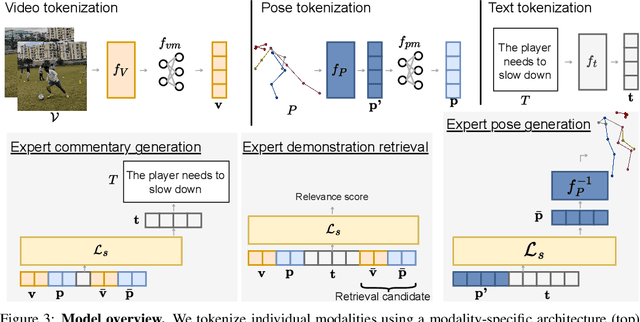
Abstract:Feedback is essential for learning a new skill or improving one's current skill-level. However, current methods for skill-assessment from video only provide scores or compare demonstrations, leaving the burden of knowing what to do differently on the user. We introduce a novel method to generate actionable feedback from video of a person doing a physical activity, such as basketball or soccer. Our method takes a video demonstration and its accompanying 3D body pose and generates (1) free-form expert commentary describing what the person is doing well and what they could improve, and (2) a visual expert demonstration that incorporates the required corrections. We show how to leverage Ego-Exo4D's videos of skilled activity and expert commentary together with a strong language model to create a weakly-supervised training dataset for this task, and we devise a multimodal video-language model to infer coaching feedback. Our method is able to reason across multi-modal input combinations to output full-spectrum, actionable coaching -- expert commentary, expert video retrieval, and the first-of-its-kind expert pose generation -- outperforming strong vision-language models on both established metrics and human preference studies.
 Add to Chrome
Add to Chrome Add to Firefox
Add to Firefox Add to Edge
Add to Edge